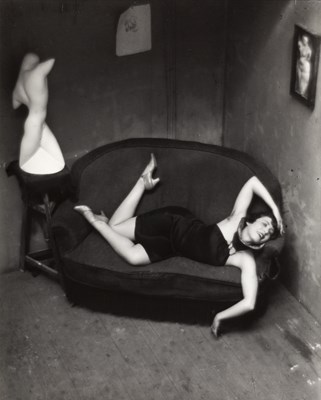18th Nov, 2023 17:00
OstLicht Photo Auction Autumn 2023
ANDRÉ KERTÉSZ (1894–1985)
'Satiric Dancer', Paris 1926
Sold for €3,600
Estimate: €3.200 - €3.800
English:
Gelatin silver print, printed in the early 1980s on double-weight semi-matte paper 35,3 x 28 cm, in excellent condition. Signed, titled and dated "Paris 1926" in pencil and annotated "MAK 0228.Y" by an unknown hand in pencil on the reverse. PROVENANCE Acquired by the current owner from Fraenkel Gallery, San Francisco.
After a decade as a young photographer in his native Hungary, Kertész moved to Paris in 1925. It was here that he took his famous photograph of the dancer Magda Förstner in the Montparnasse studio of the sculptor Beöthy, also from Hungary. The contorted pose of Magda in a short halter dress on the sofa between two of his sculptures became an icon of modern photography. The steep camera angle and the chosen lens enhance the whimsical effect of the picture, which was published in 1927 by the Berlin leisure magazine "Die Dame" to illustrate a parable about marital infidelity. After many publications, the picture received its current title in the 1960s.
Deutsch:
Silbergelatineabzug, geprintet in den frühen 1980er Jahren auf halbmattem "double-weight" Papier 35,3 x 28 cm, in ausgezeichnetem Zustand. Rückseitig mit Bleistift signiert, betitelt und datiert "Paris 1926" sowie von unbekannter Hand mit Bleistift bezeichnet "MAK 0228.Y". PROVENIENZ Vom aktuellen Besitzer erworben bei Fraenkel Gallery, San Francisco.
Nachdem einem Jahrzehnt als junger Fotograf in seiner ungarischen Heimat, zog Kertész 1925 nach Paris. Hier entstand seine berühmt gewordene Aufnahme der Tänzerin Magda Förstner im Montparnasse-Atelier seines Landsmannes und Bildhauers Beöthy. Die verrenkte Pose von Magda im kurzen Neckholder-Kleid am Sofa zwischen zweien seiner Plastiken wurde zu einer Ikone der modernen Fotografie. Der steile Blinkwinkel und die gewählte Optik verstärken die skurrile Wirkung des Bildes, das 1927 von der Berliner Freizeitzeitschrift "Die Dame" veröffentlicht wurde, um eine Parabel über eheliche Untreue zu illustrieren. Nach vielen Veröffentlichungen erhielt das Bild in den 1960er Jahren seinen heutigen Titel.
Size: 34,8 x 27,4 cm
Start price: €1.800


